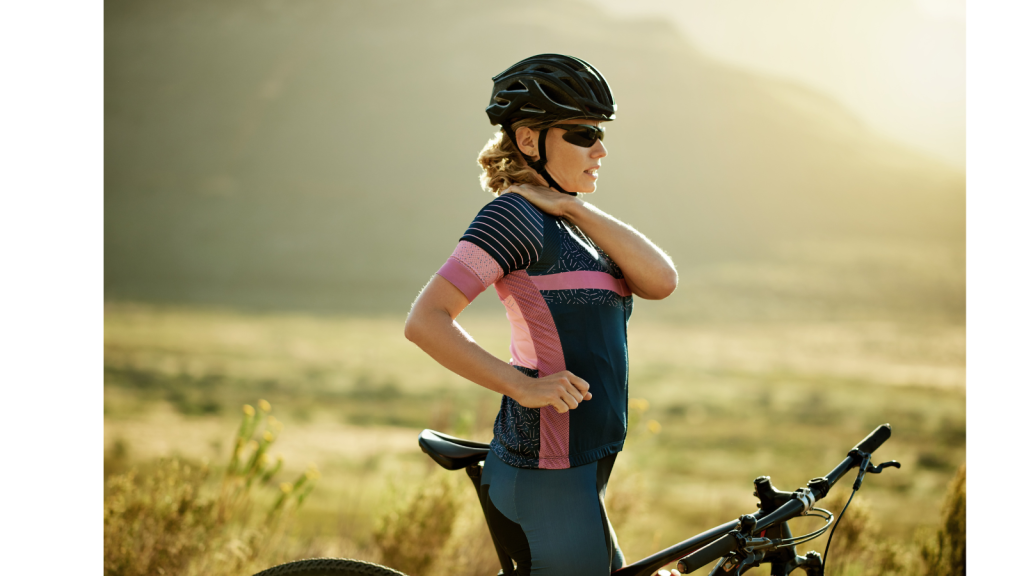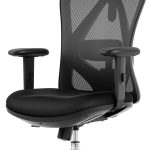
Why do Cyclists get neck pain?
Sitting on a bicycle, the cyclist’s head is positioned in front of the shoulders, engaging the muscles and putting strain on the cervical tissues. Researchers have often noticed a link between neck pain and forward head posture (FHP). FHP is the forward displacement of the head on the cervical spine. A 1996 study found that 30% of competitive British cyclists had upper back or neck pain. Too much weight on the upper limbs can often result in pain in and around the neck area. It puts too much pressure on the neck; in ideal circumstances, the hands and necks carries just 40% of the weight. The most common causes of neck pain are an uncomfortable bike fit or poor riding posture. These include:
FHP is the forward displacement of the head on the cervical spine. A 1996 study found that 30% of competitive British cyclists had upper back or neck pain. Too much weight on the upper limbs can often result in pain in and around the neck area. It puts too much pressure on the neck; in ideal circumstances, the hands and necks carries just 40% of the weight. The most common causes of neck pain are an uncomfortable bike fit or poor riding posture. These include:
- The rider having handlebars that are too low.
- Heavy impact to the neck region due to the elbows’ full extension.
- The rider must lift their head higher to prevent a poorly adjusted helmet from blocking their front vision.
- The upper cervical spine may stretch because of improperly fitted glasses, such as those that slip down the nose, forcing the wearer to see through them rather than over them.
- Holding your neck against gravity puts strain on the upper trapezius, levator scapulae & rhomboids.
- Excessive use can cause these muscles in the upper back and neck to be uncomfortably exhausted
- Blood flow into the muscles is constrained when the muscles are under persistent tension or stress for a lengthy period of time because the tiny blood capillaries are under pressure.
Common Symptoms of Neck Pain for Cyclists
The rider will complain of neck pain that worsens when riding the bike. Different symptoms, such as a dull ache at the skull base, aching in the trapezius muscles, neck pain that worsens when turning or looking up, neck discomfort coupled with headaches, and tightness between the shoulder blades and trapezius muscles, are all possible presentations.

Some other common injuries include:
Overuse injuries common among riders include: cyclists palsy, cyclists’ back, and anterior knee pain. A poorly configured cycle is frequently to blame for this. The bike fitting aim to protect all bikers from harm, boost comfort and performance, and increase efficiency.
Prevention
Correcting your bike fit to prevent neck pain
-
- Handlebar position and set up: It is the most vital part of the bike fit in preventing neck strain. The two most frequent problems are excessive drop and reach. When you experience one of these, your neck may get hyperextended. Less neck extension gives a good view of the road if there is a lift of the handlebars. In contrast, if you’re racing, you should lower the handlebar height till you’re low enough but not uncomfortable.
-
- Stem Position: There is plenty of room to elevate the bars if your stem is in the lowest position and the steerer is uncut. Simply repositioning these below the stem will change the height of the bar. Despite the fact that it may not be as fast since it is less aerodynamic, keep in mind that a strong and solid stance that you can maintain without getting hurt will ultimately be faster.
-
- Self-management: As you ride, deliberately relaxing your shoulders help a lot in reducing neck strain. Change your hands holding pattern frequently to relieve stress on joints and muscles. During the more leisurely portions of your trip, periodically stretch your neck.
Improve your riding posture
Cycling is not just about pumping your legs on the pedals, but an all-body workout. Sloppy posture puts unnecessary pressure on your vertebrae that can lead to arthritis, pinched nerves in the neck, and spinal stenosis. Even minor strains and sprains will mean less time on the tarmac and more time on the road to recovery, which looks too much like a living room and not enough slip-streams.
-
- Engage your core muscles and bring your stomach in towards your lower back
-
- Elongate your torso, which pushes the chest out a little, tilting the base of the cervical spine upwards. This reduces the strain of extending your neck
-
- Slide your shoulder blades down your back
-
- Keep your chin tucked in
-
- Stretch your neck and enjoy the view when you get the chance
Treatment
According to research, the often-employed therapies are;
-
- Joint mobilization, such as Maitland mobilizations of the upper thoracic or cervical spine as necessary, upper spine extension over a swiss ball, foam roller, or towel, and thoracic spine rotation manipulation
-
- stretching of tense muscles, such as the extensors of the upper cervical spine and the trapezius, pectorals, and cervical flexors and extensors
-
- employing ARTs to release tight myofascial/trigger points
-
- Ensure the correct bike fitting, and educate people about cycling posture and the need to keep their muscles flexible and strong.
-
- Weak muscular groups strengthening, such as the core muscles, the deep neck flexors, and the trapezius.
-
- Exercises for self-mobilization, stretching, and strengthening are part of the home exercise program (HEP).
Exercises to prevent neck pain while cycling
Forward Flexion neck exercise
-
- Sit or stand with good posture
-
- Tuck your chin in slightly and look straight ahead
-
- Gently tuck your neck forward until you feel a stretch in the back of your neck
-
- Hold for 10-30 seconds, then relax
-
- Repeat 3-5 times
Lateral Flexion neck exercise
-
- Sit or stand with good posture
-
- Gently tilt your head to the side, bringing your ear towards your shoulder
-
- Hold for 10-30 seconds, then relax
-
- Repeat on the other side
-
- Do 3-5 reps on each side
Conclusion
The joints and neck muscles in the road bike position can experience stress. Making sure your bike is correctly set up and in a posture that your body can tolerate is the best method to reduce this tension. Your body will become more accustomed to your riding position if you gradually increase the time spent on the bike to reduce overload.
With the right bike fit, correction of postural issues brought on by long periods of time on the bike, and implementation of a good maintenance program, neck pain are frequently resolved.







